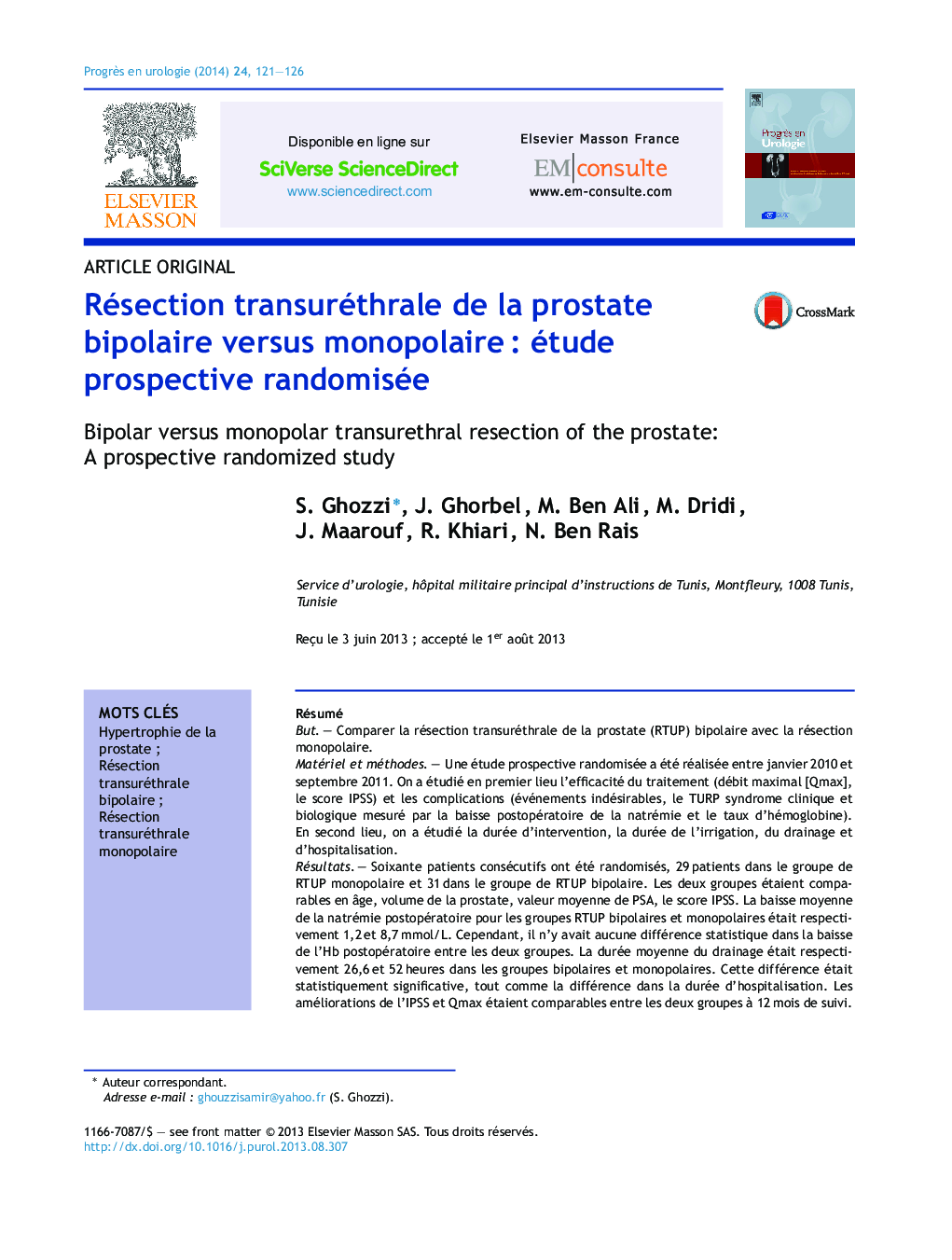| کد مقاله | کد نشریه | سال انتشار | مقاله انگلیسی | نسخه تمام متن |
|---|---|---|---|---|
| 3824232 | 1246750 | 2014 | 6 صفحه PDF | دانلود رایگان |

RésuméButComparer la résection transuréthrale de la prostate (RTUP) bipolaire avec la résection monopolaire.Matériel et méthodesUne étude prospective randomisée a été réalisée entre janvier 2010 et septembre 2011. On a étudié en premier lieu l’efficacité du traitement (débit maximal [Qmax], le score IPSS) et les complications (événements indésirables, le TURP syndrome clinique et biologique mesuré par la baisse postopératoire de la natrémie et le taux d’hémoglobine). En second lieu, on a étudié la durée d’intervention, la durée de l’irrigation, du drainage et d’hospitalisation.RésultatsSoixante patients consécutifs ont été randomisés, 29 patients dans le groupe de RTUP monopolaire et 31 dans le groupe de RTUP bipolaire. Les deux groupes étaient comparables en âge, volume de la prostate, valeur moyenne de PSA, le score IPSS. La baisse moyenne de la natrémie postopératoire pour les groupes RTUP bipolaires et monopolaires était respectivement 1,2 et 8,7 mmol/L. Cependant, il n’y avait aucune différence statistique dans la baisse de l’Hb postopératoire entre les deux groupes. La durée moyenne du drainage était respectivement 26,6 et 52 heures dans les groupes bipolaires et monopolaires. Cette différence était statistiquement significative, tout comme la différence dans la durée d’hospitalisation. Les améliorations de l’IPSS et Qmax étaient comparables entre les deux groupes à 12 mois de suivi.ConclusionAvec des résultats cliniquement comparables à la RTUP monopolaire, la RTUP bipolaire a permis une réduction de la durée d’irrigation, du délai d’ablation de la sonde vésicale et de la durée d’hospitalisation.Niveau de preuve2.
SummaryPurposeTo compare bipolar with standard monopolar transurethral resection of the prostate (TURP).Material and methodsA prospectively randomized study was conducted between January 2010 and September 2011. Primary end points studied were efficacy (maximum flow rate [Qmax], International Prostate Symptom Score) and safety (adverse events, decline in postoperative serum sodium [Na+] and haemoglobin [Hb] levels). Secondary end points were operation time and duration of irrigation, catheterization, and hospitalization.ResultsSixty consecutive patients were randomized and completed the study, with 29 patients in the monopolar TURP group and 31 in the TURIS group. At baseline, the two groups were comparable in age, prostate volume, mean prostate-specific antigen value, International Prostate Symptom Score, and they had at least 12 months of follow-up. Declines in the mean postoperative serum Na+ for bipolar and monopolar TURP groups were 1.2 and 8.7 mmol/L, respectively. However, there was no statistical difference in the decline in postoperative Hb between the two groups. The mean catheterization time was 26.6 and 52 hours in the bipolar and standard groups, respectively. This difference was statistically significant as was the difference in the time to hospital discharge. The IPSS and Qmax improvements were comparable between the two groups at 12 months of follow-up.ConclusionNo clinically relevant differences in short-term efficacy are existed between the two techniques, but bipolar TURP is preferable due to a more favorable safety profile and shorter catheterization duration.
Journal: Progrès en Urologie - Volume 24, Issue 2, February 2014, Pages 121–126